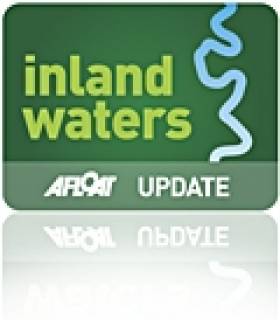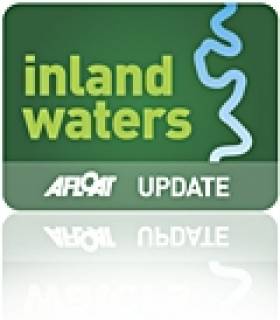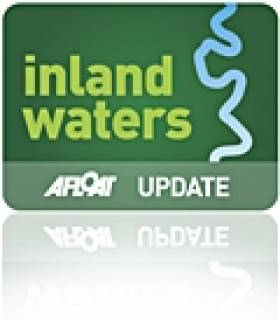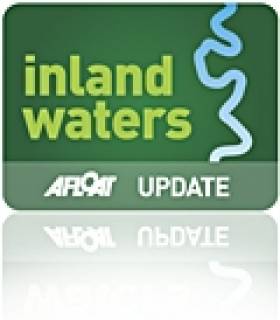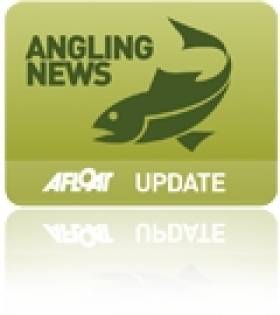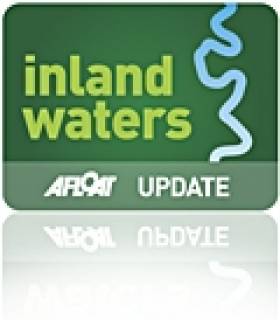Displaying items by tag: Waterways Ireland
#waterwaysireland – Dawn Livingstone has been appointed Chief Executive of Waterways Ireland and takes up post at the end of July 2013.
A committed outdoor recreationalist, Dawn joined Waterways Ireland in 2002 as the Head of Strategy & Policy. She established an Equality Scheme and led the integration of accessibility into project design and maintenance programmes. In 2008 Dawn moved to become Head of Property & Legal where she has modernised the organisations approach to both property management and legal matters.
Prior to working for Waterways Ireland, Dawn was Director of Share, a Charity promoting opportunities for integration between able bodied people and people with special needs of all age's, backgrounds and abilities. During her tenure Share grew to become a 220 bed residential activity centre on 60 acres, with a 300 seat multi-purpose theatre /arts/ bar complex, 50 berth marina, and indoor leisure suite. Dawn's entrepreneurial work in this role was recognised with the award of the Gallagher's Northern Ireland Business Women of the year winner in 1988
Dawn holds an MBA from the University of Ulster. Dawn is NI Trustee to the Family Fund, a member of the Consumer Council of NI and a Trustee of the Lloyds TSB NI Foundation. Originally from Co Down, and a keen sailor and gardener, Dawn is married with two daughters.
Big Decline In Shannon Passages Over Last 10 Years
#Shannon - Passages on the River Shannon in 2013 so far have fallen more than 50% compared to numbers for the same period a decade ago, according to the Irish Waterways History blog written by Afloat's inland correspondent, Brian Goggin.
Using statistics supplied by Waterways Ireland, the site plotted a graph that shows an overall decline in lock and bridge passages on the Shannon in the months from January to May each year since 2003, with a slight spike in 2007 the only buck in the downward trend.
Though the figures do not record all uses of the waterway (such as sailing, angling and other watersports) and do not account for variables such as the weather, they are indicative - the site claims - of "the Shannon's most significant tourism activity, the cruiser hire business".
Indeed, the figures apparently show that boat hire passage numbers have fallen from 11,440 in January-May 2003 to just 4,781 in the same months this year.
Even private boat passages have been falling from a peak in 2009 to just below their 2003 numbers, if the site's interpretation of the stats is anything to go by.
However, a source close to Afloat.ie says that the falling numbers may be skewed by a growing emphasis on larger-capacity vessels on Ireland's inland waterways, with eight- and 12-berth boats supplanting older four-berth vessels, and families and groups consolidating their recreational boating.
It will be interesting to see how the rest of the year turns out, and whether the overall numbers from January to December will tell a different story of the state of the Shannon and other waterways.
Shannon Missing Navigation Mark at Athlone
#InlandWaterways - Waterways Ireland advises masters and owners that a green starboardhand navigation mark is reported missing just south of Athlone Lock on the eastern side of the Shannon Navigation opposite the old Athlone Canal entrance.
Masters should proceed with caution when navigating this section of the river.
Elsewhere on the Shannon, a triathlon swimming training course is now set out in Lough Key between Castle Island and the mainland to the west, in an area off the navigable channel.
This will be in place until the end of September and is marked by four yellow buoys. When swimmers are on the course they will be accompanied by a safety boat and will be wearing high visibility swim hats.
Training will take place Mondays, Wednesdays and Fridays from 7am till 8am and Tuesday and Thursday from 6pm till 8pm. Masters are requested to navigate at slow speed and with a low wash when passing the area.
Further information may be had from Donal Kennedy of Lough Key Triathlon Club at 086 109 2626 or [email protected].
Meanwhile, a swimming event will take place on Sunday 9 June from Shannon Harbour to Banagher Harbour.
Masters are requested to navigate at slow speed and with a low wash when passing the area during the event, which will take place between 1pm and 3.30pm.
For more details contact Jerry O’Meara of Shannonside Sub Aqua Club at 087 776 4252 or [email protected].
#InlandWaterways - Waterways Ireland has advised all masters and users of the Erne system that the channel east of Castle Island near Enniskillen will be closed till Tuesday 11 June to facilitate a number of events on the water.
Mariners are directed to follow the marked navigation channel and signs to the west of Castle Island and proceed at a slow speed and with minimum wash. They should note any advise or instructions given by event organisers when in this section of the navigation.
Public jetties in the vicinity will remain accessible throughout, though some minor restrictions may be in place as and when required. Further information is available from the Lough Erne warden at 028 6632 3004.
Elsewhere, there will also be restricted mooring for masters and owners on the River Shannon at Carrick-on-Shannon to facilitate spectator viewing of the Carrick 400 event.
On Sunday 2 June the quay wall from the downstream face of the town bridge to the floating moorings will be out of bounds for mooring from 7pm till midnight.
In other waterways news, recent water quality testing has shown the harbour at Kilcock on the Royal Canal to now be within normal bathing water standards.
Restricted Navigation on Grand Canal in Tullamore
#GrandCanal - Waterways Ireland advises masters and owners of vessels that navigation on the Grand Canal from the mouth of the Tullamore branch line to Kilbeggan Bridge will be restricted from this Tuesday to Thursday 21-23 May.
This is to facilitate ongoing works on the Tullamore boardwalk and bridges.
Vessels that wish to transit through this section of the canal may experience some short delays during this time.
English Anglers Take Top Spots At Lough Erne Classic
#Angling - London angler Peter Vasey topped the pack at the Waterways Ireland Classic Fishing Festival in Fermanagh recently, according to the Impartial Reporter.
Vasey's total catch across two sections at Crom on Upper Lough Erne - weighing in at an impressive 39.51kg - bagged him the £5,000 (€5,944) top prize, as well as a crystal chalice and a Diawa rod and reel.
The top three places all went to mainland Brits, with the highest placing local being Nick Seddon of Enniskillen who finished fifth overall.
This was the 10th year that Waterways Ireland has sponsored the Classic, which also featured top-flight angling action in the four-man team event.
The Impartial Reporter has more on the story HERE.
Waterways Ireland CEO John Martin's Achievements
#inland waterways – John Martin, Chief Executive of Waterways Ireland, was due to retire in March 2013, but is staying on until his successor arrives. This is an opportune moment to look at his achievements.
The definition of Irish waterways has been altered several times since the end of commercial carrying about fifty years ago. They ceased to be part of a transport system but the structures still needed to be maintained, so waterways became an engineering activity, with a side order of tourism. Then Michael D Higgins seized both the initiative and the waterways, shifting them to the Heritage Service.
But the prospect of Peace In Our Time brought about a further redefinition in 1999. The assignment of waterways to a new Cross-Border Implementation Body, under the Good Friday Agreement, could be seen as anything from a step towards a united Ireland (to be welcomed or resisted depending on your politics) to a "sensible rationalisation of a waterways network" [Coakley et al 2006]. That network was now explicitly stated to be primarily for recreational purposes, and it was to be managed by a new cross-border "body".
Setting up a new organisation is not an easy task at any time. It's much harder when the context is so new, and the politics so delicate, that the organisation can't be described as anything more specific than a "body"; when you have to merge staff from large and small organisations; when you're operating across national boundaries with two legal systems, two currencies and two sets of employment law; when you have to add new functions like accounting and marketing.
Waterways Ireland has done all of that, and done it against an intensely political background, where the organisation's very existence is a political statement. It has reported to ministers in two jurisdictions, ministers whose positions may vary with the political affiliation of the incumbent. That is in addition to the usual pressures from politicians anxious to promote their own pet projects (or those of their supporters) and to the possible problems of operating in constituencies with very different political complexions.
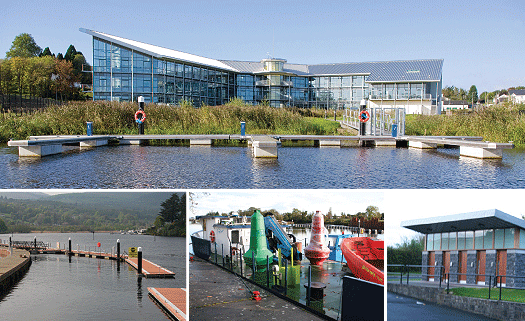
Main image: Waterways Ireland HQ at Enniskillen (courtesy Waterways Ireland), From left: New moorings and walkway at Killaloe, Inis Cealtra with buoys in Tarmonbarry, Service block at Enfield on the Royal Canal.
There have been some problems, but fewer than might have been predicted. In a context where mere survival might have been an achievement, Waterways Ireland has gone well beyond that. It was, admittedly, lucky in being able to take advantage of the late Celtic Tiger, but it made good use of the funding. The waterways are probably better equipped now than at any time since the Shannon Commissioners ceased their work, with excellent infrastructure, user facilities and capital equipment — as well as a splendid headquarters building in Enniskillen.
Perhaps more importantly, WI has brought about its own redefinition of the waterways. It has widened the range of recreational activities and drawn attention to that range. It has succeeded in attaching its own identity to the waterways, making it clear that they are managed entities, and it is now exerting control over certain areas where laxity has been the norm.
All of this adds up to a tremendous achievement. It has required work from the civil servants in the two Government departments, north and south, and the staff of the North-South Ministerial Council, as well as from politicians in both jurisdictions, but above all it reflects the hard work of the staff of Waterways Ireland, the senior management and, in particular, the retiring Chief Executive, John Martin. He has had the thanks and good wishes of politicians on all sides in the Northern Ireland Assembly and he deserves the same from all waterways users.
Entries Open For IUSRU Raft Race at Docklands Summer Fest
#InlandWaterways - The Irish Underwater Search and Recovery Unit (IUSRU) has announced details of its Raft Race as part of the Waterways Ireland Docklands Summer Festival.
Entry is €25 per person with four persons per raft for the day of wackiness on the water at Grand Canal Basin on 19 May.
And for those who can't build their own raft in time, prebuilt rafts can be supplied by the organisers.
More details of the event can be had from the IUSRU at 087 975 8656 or [email protected].
The complete programme of events for the Docklands Summer Festival will be posted on the official website shortly.
Lock One Repairs Complete On Shannon-Erne Waterway
#InlandWaterways - Waterways Ireland advises masters and owners of vessels that repairs to the lock and gates at Lock 1 Corraquill on the Shannon-Erne Waterway in Co Fermanagh which began on 29 January have now been completed.
Grand Canal City Dredging Works Completed
#GrandCanal - Waterways Ireland has issued notice that dredging works on the Dublin Main Line of the Grand Canal between Portobello and Inchicore have now been completed.
As previously reported on Afloat.ie, the works between Lock C7 at Portobello and Lock 2 at Davitt Road were instigated to keep the canal navigable for a large range of boats.
The dredging works involved the removal of sediment deposits from the central navigation channel and the clearance of rubbish.
Meanwhile, major renovation works on the city terminus of the Grand Canal at Ringsend Basin are ongoing with a view to completion in mid May.

